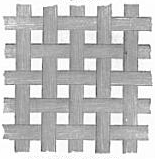Sieve facts for kids
A sieve is a tool that helps separate things based on their size. Imagine you have a mix of small and big pebbles; a sieve has tiny holes that let the small ones fall through while keeping the bigger ones behind.
In the kitchen, you might use a sifter to make sure dry ingredients like flour are smooth and free of lumps. It also helps mix air into them, making them lighter. A strainer is another type of sieve, often used to separate solid bits from liquids, like draining pasta or rinsing vegetables.
Contents
How Sieves Work
Sieving is a simple way to sort particles of different sizes. Depending on what you want to separate, sieves come with different sized holes. For example, you might use a sieve to separate small stones from sand.
Sieves are also very important in food factories. Here, large sieves, sometimes vibrating, are used to make sure no unwanted bits or foreign objects get into the food products. This helps keep our food clean and safe!
Old Wooden Sieves
Long ago, the mesh part of a wooden sieve might have been made from thin strips of wood or woven wicker. Using wood was important, especially when sieves were used for testing samples, because it helped avoid adding any unwanted materials to what was being sifted.
A book called Book of the Farm by Henry Stephens suggested that the flexible parts of a wooden sieve should be made from fir or willow wood, with American elm being the best choice. The outer rings of the sieve were often made from fir, oak, or especially beech wood. These wooden sieves were used on farms, for example, to clean grain by removing dust and soil.
Other Kinds of Sieves
There are many different types of sieves, each designed for a special job:
- Chinois: This is a cone-shaped sieve, often used in cooking to strain sauces or purees, making them very smooth.
- Cocktail strainer: A tool used by bartenders to separate ice from drinks when pouring.
- Colander: A bowl-shaped sieve, usually with larger holes, used in the kitchen to drain water from food like pasta or vegetables.
- Flour sifter: Used in baking to make flour light and remove any lumps.
- Graduated sieves: These are sets of sieves with different hole sizes, stacked on top of each other. They are used to separate materials like soil, rocks, or minerals into different size groups.
- Mesh strainer: A common type of strainer with a fine metal screen in a metal frame.
- Laundry strainer: Used in the past to lift hot laundry out of boiling water, often with a wooden frame to protect hands.
- Pickle lifter: A small tool designed to pick pickles out of a jar.
- Riddle: A type of sieve used for sifting soil, often to remove rocks or debris.
- Spider: A round, mesh-like ladle with a long handle, often used in Chinese cooking to scoop food from hot oil or water.
- Tamis: Also known as a drum sieve, it's a flat, round sieve with a fine mesh, used for sifting and pureeing.
- Tea strainer: A small sieve specifically used to catch tea leaves when pouring tea.
Other Uses of "Sieve"
Sometimes, the word "sieve" is used in other ways:
- In ice hockey, if a goaltender lets in too many goals, people might jokingly say they are a "sieve."
- The saying "leaks like a sieve" means that something, like a container, has many holes and can't hold liquid. It can also mean that an organization can't keep secrets, and information keeps getting out to the public.
Images for kids
-
An ami shakushi, a Japanese ladle or scoop used to remove small drops of batter when making tempura
See also
 In Spanish: Cedazo para niños
In Spanish: Cedazo para niños
- Cheesecloth
- Cloth filter
- Filtration
- Gold panning
- Gyratory equipment
- Mechanical screening
- Mesh (scale)
- Molecular sieve
- Separation process
- Soil gradation
- Water filter




